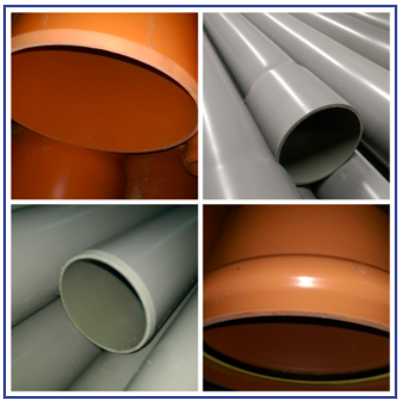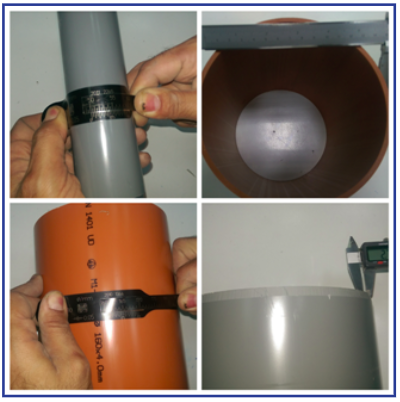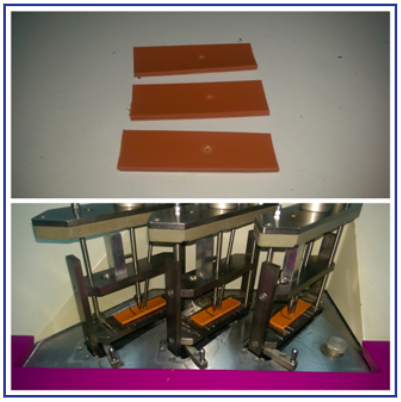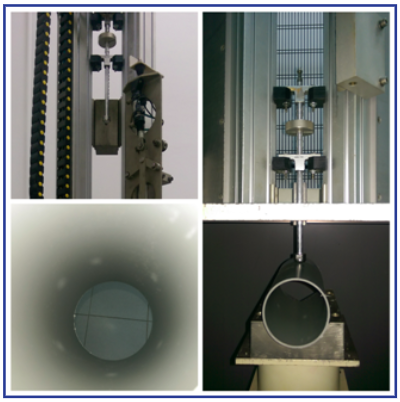Tests and controls

Pipes are considered compliant to the standard only if the following in house tests have been carried out, in line with NL–EN Standards:
- Visual Control
- Dimensional Control
- Gelification
- Longitudinal Reversion
- Vicat
- Impact Resistance
- Marking
- Pressure Test
- Specific Gravity
- Suitability for Potable Network
NL-EN Standards provide:
- Scope, definitions, general characteristics: material, appearance, colour, opacity, etc.
- Nominal Dimensions: diameter, thickness, tolerance, socket.
- Mechanical/ Physical/ Chemical characteristics
- Normalisation of marking
- Guidance for design, including derating factors
- Guidance for installation
- Recommended Practice for the application
- Rules for assessment of conformity
 Visual control
Visual control
Aspect, roughness, opacity, conformity of colour, shape of socket, spigot, chamfer, porosity, detect any trace of burning, clean cut, no irregularities,… All those controls are performed without magnification, they allow to detect any eventual trouble in the manufacturing process at the closest points of the extrusion lines.
 Dimensional control
Dimensional control
Outside diameter, wall thickness (8 points), overall length, useful length, conformity of socket (length, groove, etc.), out of roundness, angle of chamfer, length of chamfer, mean outside diameter, measured with the adequate calibrated measuring instruments. (mean wall thickness by calculation).
 Gelification
Gelification
Product is tested by immersion in methylene chloride, a very corrosive solvent, at 15°C during 30 minutes. Product tested should show no attack at any point of the pipe (internal, external, through the wall), proving that the fusion temperature has been reached. If this point is not reached, the filler used in the formulation for lubrication flows between the molecules to the surface, and proves that the polymerisation is not complete, and thus: that the properties of UPVC are not met. This aging test reveals the imperfection of the product. A product is in compliance if the mix of temperature-pressure-speed is well tuned in order to reach the fusion point (very variable acc to product, conditions, material and so on) but still not reaching the degradation stage (burning); because the measurement of the degree of fusion is very costly and almost impossible to obtain with the number of variables, the solvent test is a substitution considered as very accurate.
 Longitudinal Reversion
Longitudinal Reversion
A sample of the product is immersed in an oven during 30 minutes at 150 °C: all tensions are released at this temperature considered as the beginning of fusion (fulfilled at 180 degrees). The product is then cooled at ambient temperature, and the deformation measured (shrinkage acceptable if smaller than 5%. This test helps to identify some processing abnormalities that might affect the pipe dimensions at long term, by evaluating the effect of heating on the pipe.
 Vicat
Vicat
A sample is immersed in oil and the temperature is elevated from ambient until it reaches it s softening point (minimum acceptable is 79°C). Softening point is reached when a calibrated needle under a weight of 5kg penetrates up to 1mm into the product. Higher point demonstrates the ability of the pipe to withstand high temperature (especially for soil and waste, as well as for pressure pipes).
 Impact Resistance
Impact Resistance
A calibrated weight from a specified height falls on the product a number of times, without any friction: passing the test demonstrates the impact resistance of the PVC product.
 Marking
Marking
Should be in compliance with the requirements of the standard as well as those of the brand, should include all useful data allowing the traceability of the manufacturing process and all the steps of the quality control.
 Pressure Test
Pressure Test
Carried out regularly at high pressures, with comfortable safety factors, to demonstrate that the product may be used in normal conditions, at the working pressure rated on the product.
 Specific Gravity
Specific Gravity
It allows to verify that the PVC content complies with the requirements of the standard ( at least 80% by mass for soil and waste, and more than 88% for pressure pipes), failing which the pipe will not withstand long term operation (50 years). This test allows demonstrating that the filler content (calcium carbonate used as lubricant) does not exceed a reasonable percentage of the mixture. By using calibrated graphics, it gives more or less the same results as the ash test.
 Suitability for Potable Network
Suitability for Potable Network
Since our standard pressure pipes are manufactured lead-free, we also are in a position to provide the results of suitability for drinking water installation (metal content in compliance with the regulations as defined by Ministry of Health) tests performed externally (IRI).


